How to Spend Three Amazing Days in Lisbon
Artsy Traveler contains affiliate links for products and services I personally use and can happily recommend. As an Amazon Associate, I earn from qualifying purchases. Please read the Disclosure for more information. If you make a purchase through these links, at no additional cost to you, Artsy Traveler earns a small commission. Thank you!
Thinking of visiting Lisbon?
It’s a beautiful city that deserves a stay of at least two or three nights. You want to be able to enjoy Lisbon at night when the crowds dissipate and the sounds of Fado waft from cafes in the Alfama and Bairro Alto.
Ideally, stay three nights so you have one full day to explore Lisbon and another day for a trip out to magical Sintra.
In this post, I share my suggestions for enjoying Lisbon.
Lisbon Highlights at a Glance
- Get the lay of the land about Lisbon history at the Lisboa Story Center
- Enjoy a Fado performance in the Bairro Alto district
- Visit the Gulbenkian Foundation to view world-class art
- Stay at the stylish Vincci Baixa in Lisbon
- Take a tour out to fabulous Sintra and don’t miss the Moorish castle
Overview
Most of your Lisbon sightseeing will be concentrated in the three adjacent and historic Lisbon neighborhoods.
Imagine you’re facing downtown Lisbon with your back to the Tagus River (Rio Tejo).
The Bairro Alto is on the hill to your left; the Baixa-Chiado district (or just Baixa), with its orderly grid of streets is in the center; and the twisty lanes of the ancient Moorish district of the Alfama crawl up the hill to your right, crowned by the Castelo São Jorge.
By basing yourself in one of these three districts, you can walk almost everywhere. When you get tired of walking, hail a taxi (not expensive in Lisbon) or hop on one of the historic trams.
They clatter and shudder up the steep hills and, although packed with fellow tourists, are a lot of fun to ride at least once.
Take the metro or a bus out to the Gulbenkian and to the Belém district, and catch the train to Sintra from the Rossio train station at Praça Rossio.
Day 1: Arrive in Lisbon
If you’re arriving in Lisbon after a driving tour around Portugal, drop you car at the airport and take a taxi into Lisbon. Avoid driving in Lisbon. The streets are very narrow and the hills very steep.
I suggest booking a hotel in the central Baixa-Chiado district. I’ve stayed in all three districts, but I most enjoyed staying in the Baixa because it is the most central of the three districts. The Vincci Baixa where I stayed is only about a block from the massive Praça do Comércio with its breezy outdoor cafés and stunning views of the Tagus River.
Alfama
Walk to the Alfama district, tour the Fado Museum, then climb the narrow streets to the Castelo São Jorge. You’ll be rewarded with great views over Lisbon.
The streets and houses in the ancient Alfama have retained some of their old world charm, but the area feels cleaned up, and the atmosphere has changed over the ten years since we first visited Lisbon.
In 2010 when I stayed for a week at an apartment in the Alfama, a rooster was tethered to a leash a few meters from our front door, salted cod hung in the windows of tiny grocery stores, and I never saw a souvenir shop.
On my last visit post-COVID, the Alfama swarmed with tourists, the salted cod was a memory, and souvenir shops abounded.
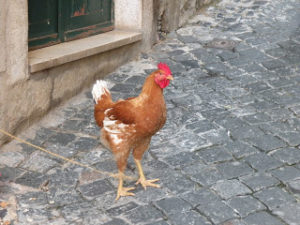
It wasn’t an improvement.
But go for a wander through the area anyway. If you visit towards the end of the day when the crowds have thinned, you’ll get a bit of the Moorish/Medieval vibe.
Lisboa Story Center
After spending time in the Alfama, walk into the Praça do Comércio, and check out the Lisboa Story Center. It’s open until 8 pm (last entry at 7 pm), making it a great early evening stop.
Buy tickets and an audio guide ahead of time to skip the lines. The Lisboa Story Center can get crowded.
Yes, it’s touristy, but I thoroughly enjoyed the interactive displays chronicling the history of Lisbon. You don an audio headset and take a 60-minute journey back in time. The displays are engaging and interesting.
Enjoying this post? Subscribe to Artsy Traveler to Receive Valuable Travel Tips and Your FREE Guide: 25 Must-Do Artsy Traveler Experiences in Europe for 2025

For part of the journey, you enter a sensory theater to experience the 1755 earthquake that devastated Lisbon. I was also intrigued by the displays about the Carnation Revolution of 1974 and the making of modern-day Portugal.
Evening of Day 1
Enjoy dinner in one of the outdoor cafés in the Praça do Comércio, then stroll up the wide avenues of the Baixa to the Praça do Rossio, the central square with its wonderful wavy brickwork. Stop for a drink and watch Lisbon go by.
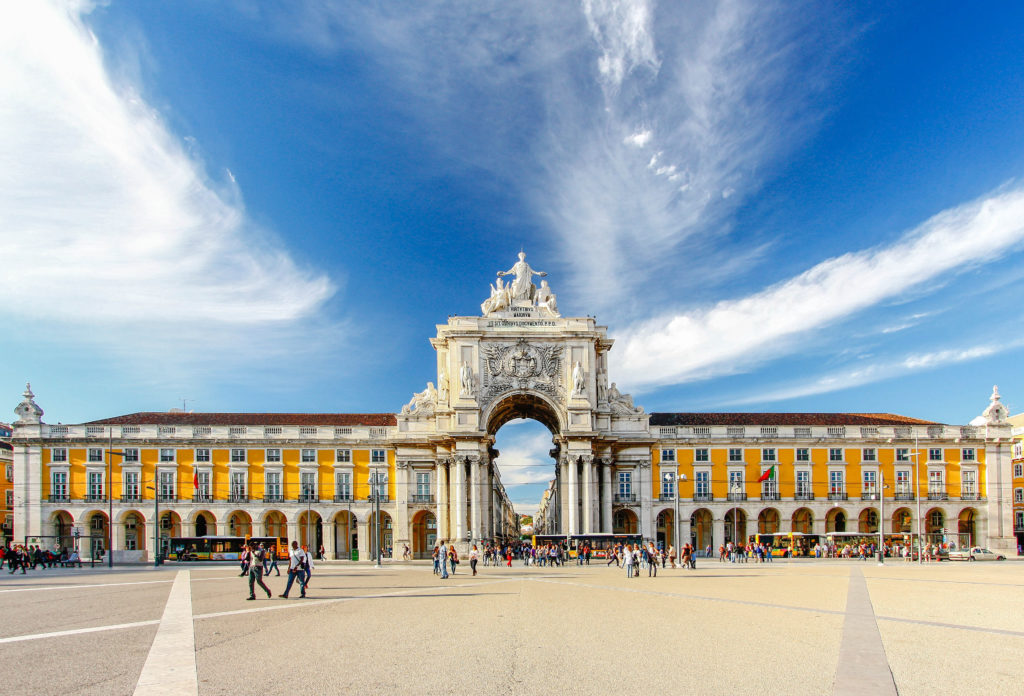
Day 2: All Day in Lisbon
If you’re staying in the Baixa, skip the expensive hotel breakfast and grab a coffee and a croissant at an outdoor café.
Calouste Gulbenkian Foundation
Head out early to enjoy a morning of fabulous art at the Calouste Gulbenkian Foundation. This place blows me away! Take the metro (blue and red line) to S. Sebastião.
Get your tickets online in advance to avoid waiting in line.
The Gulbenkian features a spectacular collection of sculptures, paintings, jewelry, furniture, and other objets d’art from Egyptian times to the present.
Another attraction is the 7.5-hectare park surrounding the buildings that make up the foundation.
Belém
From downtown Lisbon, head to Belém on either the E15 tram or the 728 bus. It will drop you in front of the Mosteiro dos Jeronimos.
Several of Lisbon’s iconic tourist attractions, as well as great views of the Tejo Estuary, are located in the stylish Belém district in west Lisbon. This area has enough attractions to fill a day, but with only an afternoon, here’s what I suggest you see, in this order.
Mosteiro dos Jeronimos
Tour this ornate UNESCO World Heritage Site that’s one of the foremost examples of the Manueline architecture and one of Portugal’s most decorative churches.
See lots of spindly columns and fine stonework that remind me of icing sugar decorations on a wedding cake. The huge, two-level cloister is worth seeing. This place gets mobbed with tourists so buy your tickets in advance. Here’s an option that also includes a tour of Belém:
Berardo Museum of Modern and Contemporary Art
Located close to the Jeronimos Monastery, this new museum was touted as the most visited museum in Portugal, according to The Art Newspaper.
The Berardo Museum presents the most significant artistic movements from the 20th century to the present day. Artists include Picasso, Duchamp, Mondrian, Miró, Ernst, and Bacon.
Two Iconic Monuments
When you’re in Belém, you can’t miss the two monuments that everyone comes to see: the iconic Belém Tower (Torre Belém) and the Monument to the Discoveries (Padrão dos Descobrimentos).
The Belém Tower is one of Lisbon’s most photographed sites. The Tower was built in the 16th century to protect the coast from attackers.
Stroll along the river to the Monument to the Discoveries (Padrão dos Descobrimentos), a striking, modern structure rebuilt in 1960 to celebrate 33 prominent figures in Portugal’s Age of Discoveries, including Henry the Navigator. A great photo op!
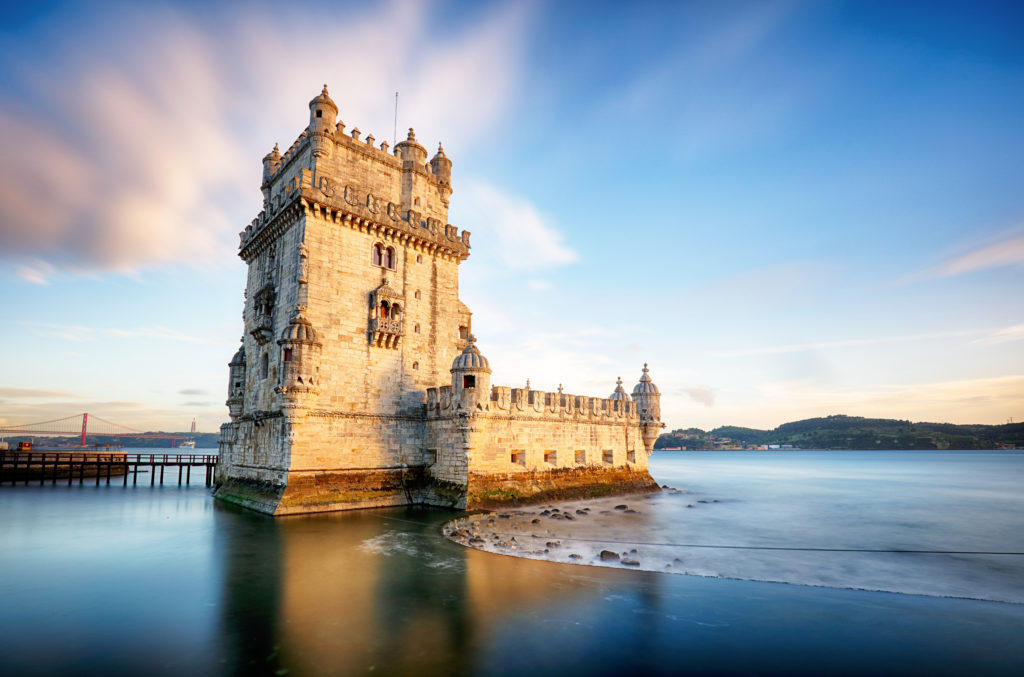

And, if you have time, sample the famous pastéis de nata at the Pastéis de Belém, reputed to be the best place in Lisbon to enjoy the creamy custard tarts in puff pastry.
If not, don’t worry; these tarts are on the menu of every café in Portugal (and I ate my fair share of them).
Fado Performance
In the evening, head to the Bairro Alto for dinner and fado. Showy tourist shows are available, but I prefer prowling the back streets of the area in search of small restaurants and less touristy shows.
My favorite place in Lisbon is Restaurante Canto do Camões on Travessa da Espera in the Bairro Alto. It’s low-key, with a friendly owner, good food, reasonable prices, and lots of fado.
When I was there, singers dropped in, performed a few songs designed to rip your heart out, collected a few euros from the proprietor, and then left, presumably to go sing in another place.
Restaurante Canto do Camões doesn’t appear to have a website, but you’ll find reviews on TripAdvisor. It’s not the flashiest place in Lisbon, but it feels authentic and I loved it.
You can also purchase tickets for one of the slick fado performances designed for tourists. Here’s one option:
Day 3: Sintra
Fill your last day in Portugal with the heady delights of Sintra. Even Byron mentioned it in his epic poem, Childe Harold’s Pilgrimage: Lo! Cintra’s glorious Eden intervenes, in variegated maze of mount and glen.
Old Byron did have a way with words.
Catch the direct train from Rossio station to Sintra. The round-trip costs €4,30. Another option is to take a day tour from Lisbon.
The town of Sintra, with its pastel-colored mansions, is delightful, but the two big draws are the Pena Palace, with its Romanesque-Revival architecture, and the Moorish Castle.
Pena Palace
Get tickets ahead of time for the Pena Palace, and be prepared for a crush as you tour it.
Bus 434 from the Sintra train station does a circular loop through the historic center, up to the Pena Palace and the Moorish Castle, then back to Sintra. Or you can visit the castle after seeing the palace and walk down along a 2- kilometer trail.
The place is a fairy tale on acid—so bizarre with its turrets and bright colors that you can’t help smiling with disbelief and a touch of awe. What kind of mind envisioned it?
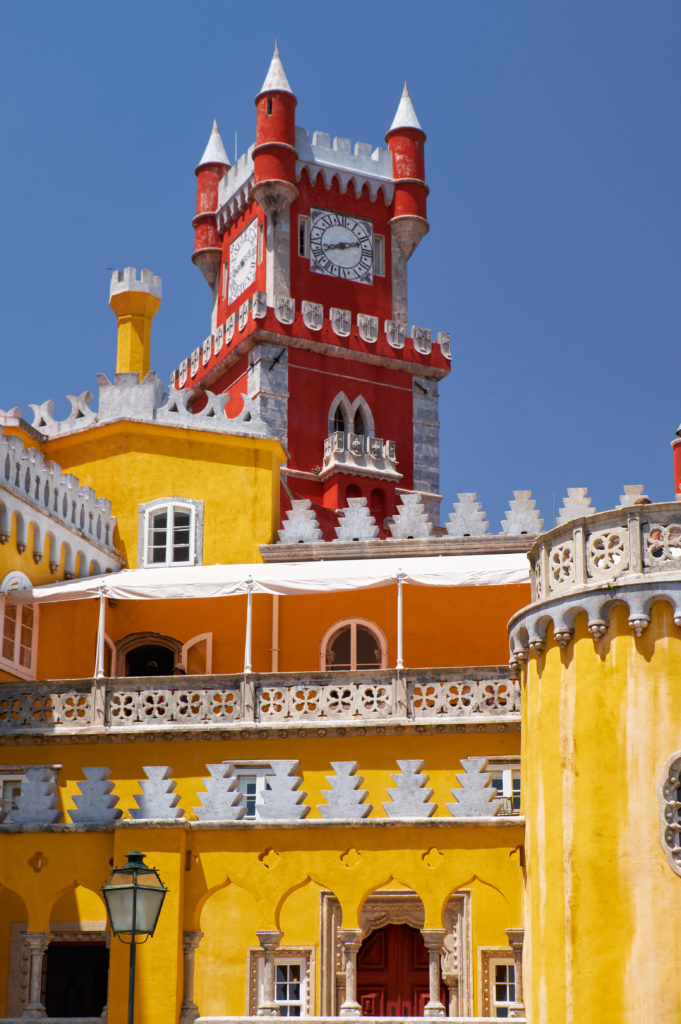
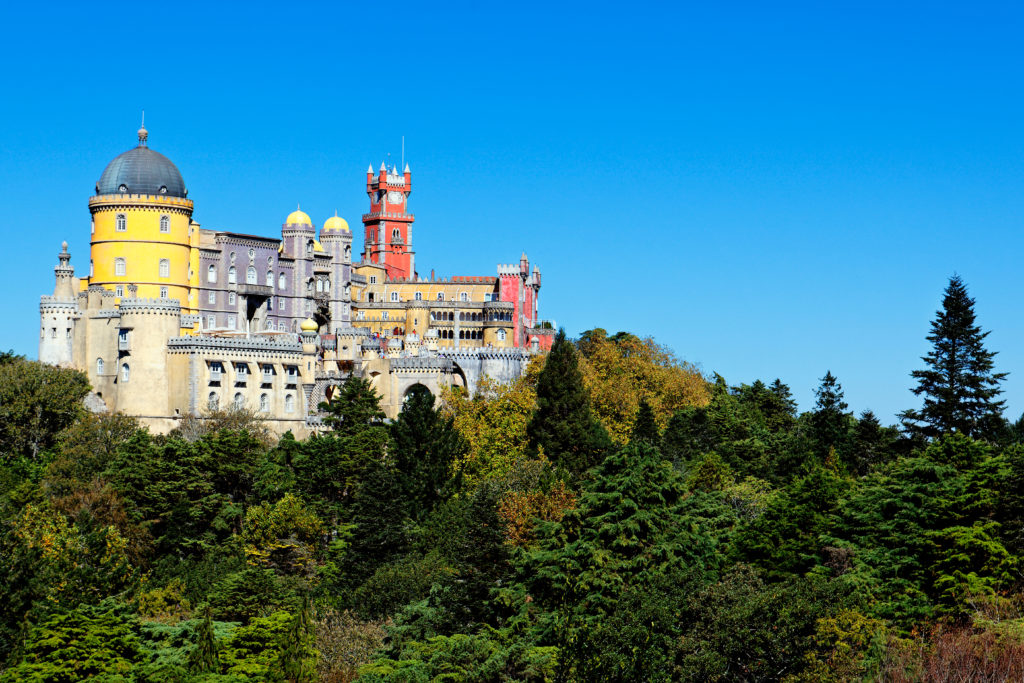

Moorish Castle
After going through the palace, walk down to the Castelo dos Mouros—the Moorish Castle. It’s usually less crowded than the palace. The views from the castle’s 10th-century ramparts take your breath away.
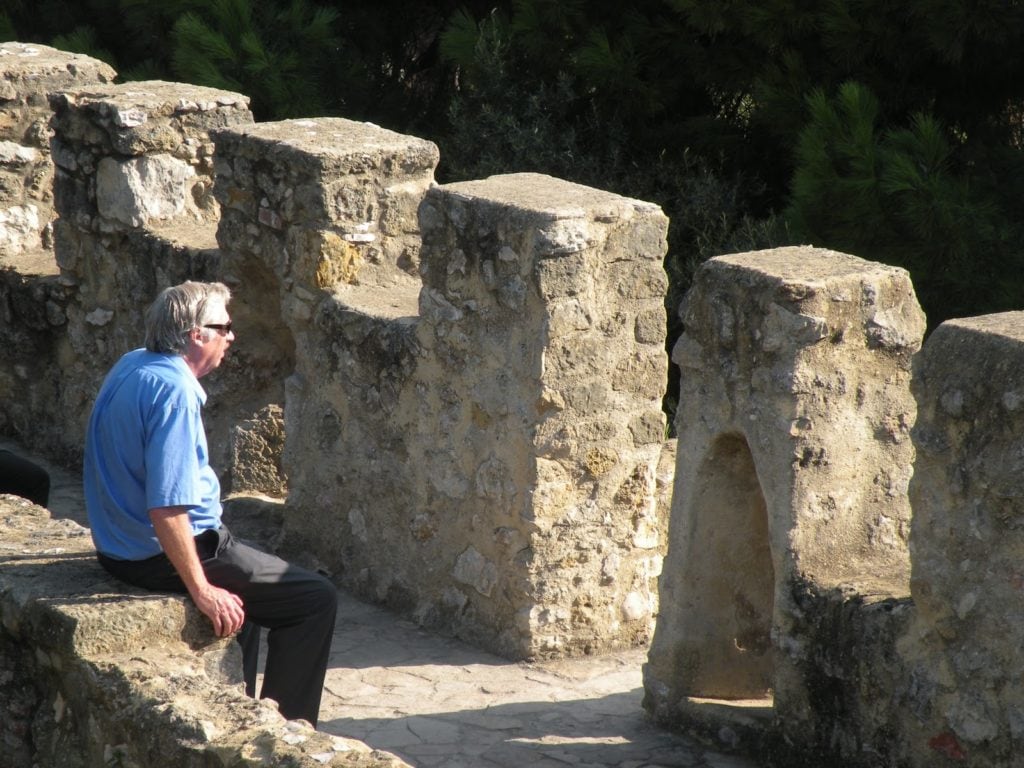
Other Sites in Sintra
You’ll find plenty more to see in Sintra, including the National Palace of Sintra and the wonderfully ornate Monserrate Palace. Consider staying in Sintra on your last night.
Lawrence’s Hotel, now a UNESCO World Heritage site, opened in 1764, making it the oldest functioning hotel on the Iberian Peninsula. All the rooms have names rather than numbers.
If you do stay longer in Sintra, catch the bus out to Cabo de Roca, the westernmost point of Europe. Enjoy incredible views from the rocky cliffs along with the feeling of standing on the edge of a continent, because you are.
Where to Stay in Lisbon
For accommodation suggestions in Lisbon and Sintra, see Where to Stay in Portugal: My Best Picks.
Tickets and Tours in Lisbon
Here are some more options for tickets and tours purchased through GetYourGuide:
And how about a walking tour? GuruWalks provides some good options for exploring Lisbon on foot with a local guide:
Conclusion
Have you visited Lisbon? Please share your recommendations in the comments below.
Here are more posts about things to see in Portugal and Europe:
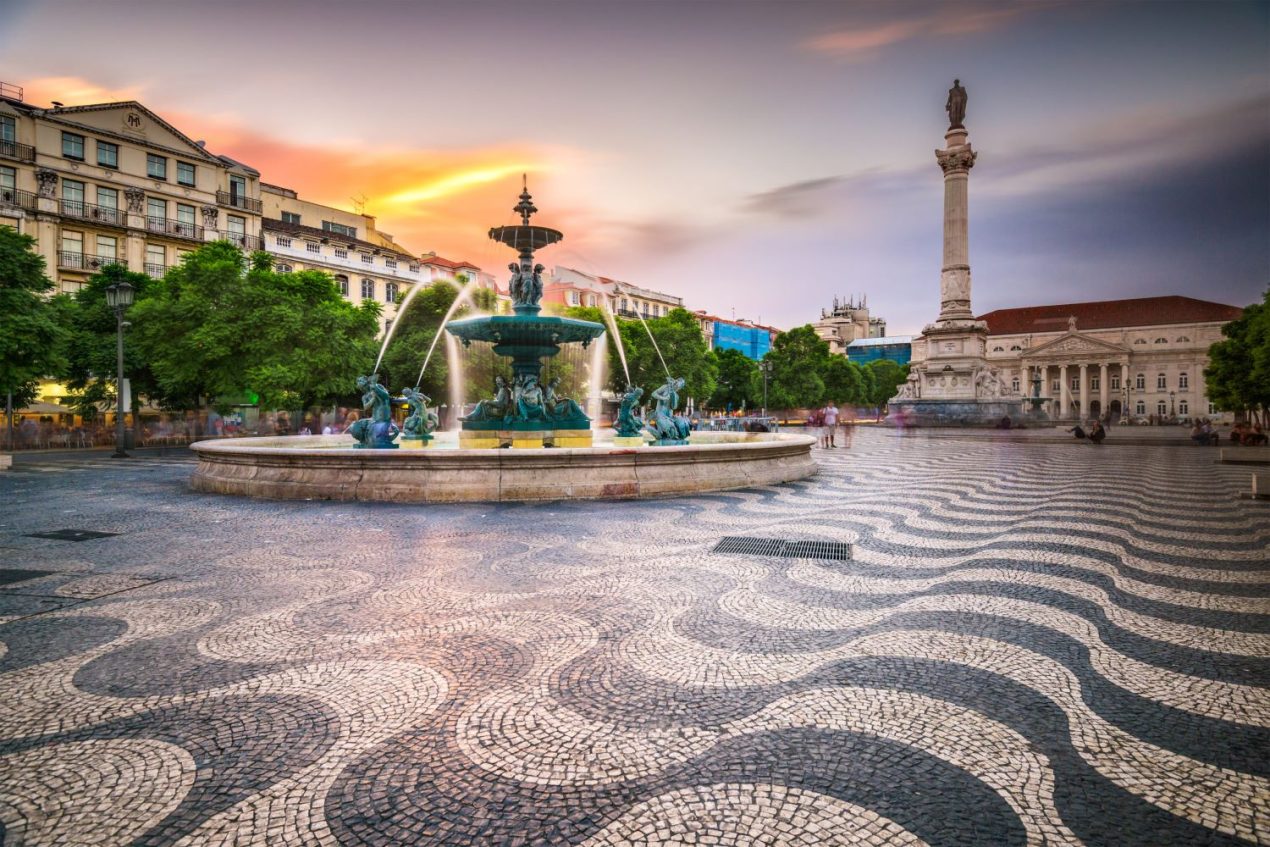

[…] Three Amazing Days in Lisbon […]
[…] Three Amazing Days in Lisbon […]